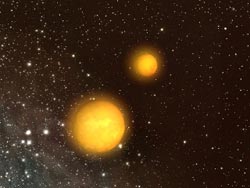Cosmic clash caught in act

Two neutron stars about to collide
Danish astrophysicists have for the first time observed the visible light from a so-called short gamma-ray burst. Observations show that these short, intense bursts of gamma-ray emission most likely originate from the violent collision of two merging neutron stars. The results are being published in Nature on October 6th.
Stars do not always meet gently. Two neutron stars rarely meet, but when they do, they smash into each other and the expected result is a short, gigantic explosion.
A research team lead by Prof. Jens Hjorth at the new Dark Cosmology Centre, Niels Bohr Institute, University of Copenhagen has observed a so-called short gamma-ray burst with the Danish 1.5 metre telescope at ESO, La Silla in Chile. For the first time since the mysterious gamma-ray bursts were discovered more than 30 years ago, visible light was detected from a short burst. The energetic gamma radiation lasts less than 2 seconds and as such they are extremely difficult to catch. The discovery of visible light from a short gamma-ray burst has now paved the way for unravelling the secrets of these enigmatic cosmic explosions.
In 2003 Jens Hjorth and an international team established that long (more than 2 seconds) gamma-ray bursts are intimately linked to supernova explosions, the spectacular death of single, massive stars. The discovery on short gamma-ray bursts shows that these are also distant, cosmic explosions, but of a different origin. Future observations of short as well as long gamma-ray bursts will reveal the extreme conditions that prevail when stars are dying. Due to their enormous power release, gamma-ray bursts can be seen throughout the visible Universe; their light carries information about the most remote locations and from a time when the Universe was still in its infancy.
Media Contact
More Information:
http://www.nbi.ku.dkAll latest news from the category: Physics and Astronomy
This area deals with the fundamental laws and building blocks of nature and how they interact, the properties and the behavior of matter, and research into space and time and their structures.
innovations-report provides in-depth reports and articles on subjects such as astrophysics, laser technologies, nuclear, quantum, particle and solid-state physics, nanotechnologies, planetary research and findings (Mars, Venus) and developments related to the Hubble Telescope.
Newest articles

Airborne single-photon lidar system achieves high-resolution 3D imaging
Compact, low-power system opens doors for photon-efficient drone and satellite-based environmental monitoring and mapping. Researchers have developed a compact and lightweight single-photon airborne lidar system that can acquire high-resolution 3D…

Simplified diagnosis of rare eye diseases
Uveitis experts provide an overview of an underestimated imaging technique. Uveitis is a rare inflammatory eye disease. Posterior and panuveitis in particular are associated with a poor prognosis and a…

Targeted use of enfortumab vedotin for the treatment of advanced urothelial carcinoma
New study identifies NECTIN4 amplification as a promising biomarker – Under the leadership of PD Dr. Niklas Klümper, Assistant Physician at the Department of Urology at the University Hospital Bonn…





















